The Battle of Britain begins - 10th July 1940
Header image: Hawker Hurricane Mk 1s of 85Sqn on patrol in 1940.
In the United Kingdom the Battle of Britain is officially recognised as having started 80 years ago on 10th July 1940.
The fighting in France and the Low Countries, and the Dunkirk operations during May 1940, had been very costly for the RAF, which lost 959 aircraft, including 477 fighters (219 of them from Fighter Command). The Luftwaffe also suffered heavy losses. This forced something of a brief lull, during which both sides tried to bring units back up to full strength. However, this did not mean that there was no activity over Britain before the Battle officially began. There were sizeable German air raids on 5-6th June, when around 30 aircraft attacked airfields, and on most nights after that. By 7th July RAF Fighter Command could field 644 fighter aircraft and 1,259 pilots. The two Luftwaffe air fleets in Belgium and north-western France had around 7-800 single-engine Bf 109 fighters, 200 twin-engine BF 110s, 1,000-1,200 bombers and just under 300 dive bombers. On 9th July, the day before the Battle officially began, Fighter Command lost two pilots killed and three wounded.
The first RAF fighter pilot to be lost in the Battle of Britain was 22-year-old Sergeant Pilot Ian Clenshaw of 253 Squadron, who was killed in a flying accident during a dawn patrol in poor weather on 10th July. He took off from Kirton-in-Lindsey, Lincolnshire, and was killed when his Hurricane, P3359, crashed near the Humber coast.

On 10th July, German bombers and fighter escorts struck at a British shipping convoy in the English Channel, while more bombers attacked dockyard installations at Falmouth and Swansea. Twenty-two Hurricanes from 32, 56 and 111 Squadrons, and eight Spitfires of 74 Squadron were scrambled from Manston, Biggin Hill, Hornchurch, Kenley and Croydon in the south-east of England to meet the German raid over the Channel. The RAF fighters clashed with 26 Dornier Do-17s and Do-215s, 30 BF 110s and 20 BF 109s over the Channel off Folkestone. 111 Squadron’s C.O., Squadron Leader John Thompson, led his Hurricanes in a line-abreast, head-on attack against the German bombers. One of the 111 Squadron Hurricanes, P3761, flown by Flying Officer Peter Higgs, collided with a Do-17, possibly whilst taking evasive action when he was attacked by the Bf 109 of Oberleutnant Ouesau. Higgs’ Hurricane lost a wing in the collision at 6,000 feet. He baled out, but drowned after a rescue launch was unable to find him. Higgs had previously been credited with destroying a Bf 109 and probably destroying a Do-17 during June. He became the first RAF fighter pilot to be lost in action in the Battle of Britain. He was 23 years old. His body was washed ashore on the Dutch coast five days later and he is buried in the Noordwijk General Cemetery. The Dornier of 3/KG 2 crashed near Dungeness Buoy; two of its crew were rescued and taken prisoner of war. Overall, on the first day of the Battle the Germans lost 13 aircraft; the RAF lost six, with two pilots killed.

Lest we forget







